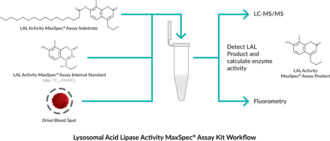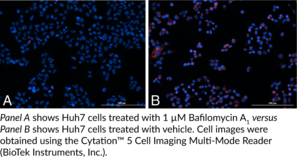Cayman
Showing 28351–28500 of 45550 results
-
Lysine-specific demethylase inhibitor (1C) (LSD inhibitor (1C)) is an inhibitor of LSD1, a repressive demethylase selective for histone H3 lysine 4 (H3K4).{18521,16614} LSD inhibitor (1C) inhibits LSD1 activity by 85.9% when used at a concentration of 10 µM.{18521} It increases the level of H3K4 methylation, including H3K4me1 and H3K4me2 but not H3K9me2 levels, in HCT116 human colon carcinoma cells.{16614} LSD inhibitor (1C) also induces re-expression of the Wnt signaling pathway proteins secreted frizzle-related protein 1 (SFRP1), SFRP4, and SFRP5, as well as the transcription factor GATA5, which are aberrantly silenced in HCT116 cells.
Brand:CaymanSKU:-Lysine-specific demethylase inhibitor (1C) (LSD inhibitor (1C)) is an inhibitor of LSD1, a repressive demethylase selective for histone H3 lysine 4 (H3K4).{18521,16614} LSD inhibitor (1C) inhibits LSD1 activity by 85.9% when used at a concentration of 10 µM.{18521} It increases the level of H3K4 methylation, including H3K4me1 and H3K4me2 but not H3K9me2 levels, in HCT116 human colon carcinoma cells.{16614} LSD inhibitor (1C) also induces re-expression of the Wnt signaling pathway proteins secreted frizzle-related protein 1 (SFRP1), SFRP4, and SFRP5, as well as the transcription factor GATA5, which are aberrantly silenced in HCT116 cells.
Brand:CaymanSKU:-Lysipressin is a vasopressin peptide originally identified in pigs but also found in some marsupial species.{38886,38887} It has antidiuretic effects in non-anesthetized dwarf pigs, decreasing urine volume and increasing urinary solutes without affecting the glomerular filtration rate.{38886} Lysipressin has less potent antidiuretic effects than arginine vasopressin in dogs.
Brand:CaymanSKU:24218 - 1 mgAvailable on backorder
Lysipressin is a vasopressin peptide originally identified in pigs but also found in some marsupial species.{38886,38887} It has antidiuretic effects in non-anesthetized dwarf pigs, decreasing urine volume and increasing urinary solutes without affecting the glomerular filtration rate.{38886} Lysipressin has less potent antidiuretic effects than arginine vasopressin in dogs.
Brand:CaymanSKU:24218 - 10 mgAvailable on backorder
Lysipressin is a vasopressin peptide originally identified in pigs but also found in some marsupial species.{38886,38887} It has antidiuretic effects in non-anesthetized dwarf pigs, decreasing urine volume and increasing urinary solutes without affecting the glomerular filtration rate.{38886} Lysipressin has less potent antidiuretic effects than arginine vasopressin in dogs.
Brand:CaymanSKU:24218 - 25 mgAvailable on backorder
Lysipressin is a vasopressin peptide originally identified in pigs but also found in some marsupial species.{38886,38887} It has antidiuretic effects in non-anesthetized dwarf pigs, decreasing urine volume and increasing urinary solutes without affecting the glomerular filtration rate.{38886} Lysipressin has less potent antidiuretic effects than arginine vasopressin in dogs.
Brand:CaymanSKU:24218 - 5 mgAvailable on backorder
Lyso-globotriaosylceramide is a form of globotriaosylceramide that is lacking the fatty acyl group. It binds to Shiga toxin 1 (Stx1) in the presence of cholesterol and phosphatidylcholine but does not bind Stx2.{36643} It also reduces viability and aggregation of human neutrophils induced by phorbol 12-myristate 13-acetate (PMA; Item No. 10008014) when used at concentrations of 50 and 1 μM, respectively.{38972} Lyso-globotriaosylceramide accumulates in the brain, heart, kidney, liver, lung, and spleen in a mouse model of Fabry disease, a lysosomal storage disorder characterized by a deficiency in the enzyme α-galactosidase A.{41495} It also accumulates in the urine, kidney, and plasma of patients with Fabry disease.{36644} Lyso-globotriaosylceramide levels decrease in response to administration of the α-galactosidase inhibitor 1-deoxygalactonojirimycin (migalastat; Item No. 17179) in a transgenic mouse model of Fabry disease. Decreases in plasma and urine concentrations of lyso-globotriaosylceramide have been used as a biomarker for efficacy of enzyme replacement therapy (ERT) and other therapies in the treatment of Fabry disease. [Matreya, LLC. Catalog No. 1520]
Brand:CaymanSKU:24873 - 1 mgAvailable on backorder
Lyso-PAF C-16 can be formed by either the action of PAF-AH on PAF C-16,{2626} or by the action of a CoA-independent transacylase on 1-O-hexadecyl-2-acyl-glycerophosphocholine.{240,2098} Lyso-PAF C-16 is a substrate for either PAF C-16 formation by the remodeling pathway{939} or selective acylation with arachidonic acid by a CoA-independent transacylase.{2101}
Brand:CaymanSKU:60906 - 1 mgAvailable on backorder
Lyso-PAF C-16 can be formed by either the action of PAF-AH on PAF C-16,{2626} or by the action of a CoA-independent transacylase on 1-O-hexadecyl-2-acyl-glycerophosphocholine.{240,2098} Lyso-PAF C-16 is a substrate for either PAF C-16 formation by the remodeling pathway{939} or selective acylation with arachidonic acid by a CoA-independent transacylase.{2101}
Brand:CaymanSKU:60906 - 10 mgAvailable on backorder
Lyso-PAF C-16 can be formed by either the action of PAF-AH on PAF C-16,{2626} or by the action of a CoA-independent transacylase on 1-O-hexadecyl-2-acyl-glycerophosphocholine.{240,2098} Lyso-PAF C-16 is a substrate for either PAF C-16 formation by the remodeling pathway{939} or selective acylation with arachidonic acid by a CoA-independent transacylase.{2101}
Brand:CaymanSKU:60906 - 25 mgAvailable on backorder
Lyso-PAF C-16 can be formed by either the action of PAF-AH on PAF C-16,{2626} or by the action of a CoA-independent transacylase on 1-O-hexadecyl-2-acyl-glycerophosphocholine.{240,2098} Lyso-PAF C-16 is a substrate for either PAF C-16 formation by the remodeling pathway{939} or selective acylation with arachidonic acid by a CoA-independent transacylase.{2101}
Brand:CaymanSKU:60906 - 5 mgAvailable on backorder
Lyso-PAF C-16-d4 contains four deuterium atoms at the 7, 7′, 8, and 8′ positions of the hexadecyl moiety. It is intended for use as an internal standard for the quantification of PAF C-16 by GC- or LC-mass spectrometry. Lyso-PAF C-16 can be formed by either the action of PAF-AH on PAF C-16,{2626} or by the action of a CoA-independent transacylase on 1-O-hexadecyl-2-acyl-glycerophosphocholine.{240,2098} Lyso-PAF C-16 is a substrate for either PAF C-16 formation by the remodeling pathway{939} or selective acylation with arachidonic acid by a CoA-independent transacylase.{2101}
Brand:CaymanSKU:360906 - 1 mgAvailable on backorder
Lyso-PAF C-16-d4 contains four deuterium atoms at the 7, 7′, 8, and 8′ positions of the hexadecyl moiety. It is intended for use as an internal standard for the quantification of PAF C-16 by GC- or LC-mass spectrometry. Lyso-PAF C-16 can be formed by either the action of PAF-AH on PAF C-16,{2626} or by the action of a CoA-independent transacylase on 1-O-hexadecyl-2-acyl-glycerophosphocholine.{240,2098} Lyso-PAF C-16 is a substrate for either PAF C-16 formation by the remodeling pathway{939} or selective acylation with arachidonic acid by a CoA-independent transacylase.{2101}
Brand:CaymanSKU:360906 - 100 µgAvailable on backorder
Lyso-PAF C-16-d4 contains four deuterium atoms at the 7, 7′, 8, and 8′ positions of the hexadecyl moiety. It is intended for use as an internal standard for the quantification of PAF C-16 by GC- or LC-mass spectrometry. Lyso-PAF C-16 can be formed by either the action of PAF-AH on PAF C-16,{2626} or by the action of a CoA-independent transacylase on 1-O-hexadecyl-2-acyl-glycerophosphocholine.{240,2098} Lyso-PAF C-16 is a substrate for either PAF C-16 formation by the remodeling pathway{939} or selective acylation with arachidonic acid by a CoA-independent transacylase.{2101}
Brand:CaymanSKU:360906 - 500 µgAvailable on backorder
Lyso-PAF C-18 can be formed by either the action of PAF-AH on PAF C-18{2626} or by the action of a CoA-independent transacylase on 1-O-octadecyl-2-acyl-glycerophosphocholine.{240,2098} Lyso PAF C-18 is a substrate for either PAF C-18 formation by the remodeling pathway{939} or selective acylation with arachidonic acid by a CoA-independent transacylase.{2101}
Brand:CaymanSKU:60916 - 1 mgAvailable on backorder
Lyso-PAF C-18 can be formed by either the action of PAF-AH on PAF C-18{2626} or by the action of a CoA-independent transacylase on 1-O-octadecyl-2-acyl-glycerophosphocholine.{240,2098} Lyso PAF C-18 is a substrate for either PAF C-18 formation by the remodeling pathway{939} or selective acylation with arachidonic acid by a CoA-independent transacylase.{2101}
Brand:CaymanSKU:60916 - 10 mgAvailable on backorder
Lyso-PAF C-18 can be formed by either the action of PAF-AH on PAF C-18{2626} or by the action of a CoA-independent transacylase on 1-O-octadecyl-2-acyl-glycerophosphocholine.{240,2098} Lyso PAF C-18 is a substrate for either PAF C-18 formation by the remodeling pathway{939} or selective acylation with arachidonic acid by a CoA-independent transacylase.{2101}
Brand:CaymanSKU:60916 - 25 mgAvailable on backorder
Lyso-PAF C-18 can be formed by either the action of PAF-AH on PAF C-18{2626} or by the action of a CoA-independent transacylase on 1-O-octadecyl-2-acyl-glycerophosphocholine.{240,2098} Lyso PAF C-18 is a substrate for either PAF C-18 formation by the remodeling pathway{939} or selective acylation with arachidonic acid by a CoA-independent transacylase.{2101}
Brand:CaymanSKU:60916 - 5 mgAvailable on backorder
LysoFP-NH2 is the fluorescent form of the lysosomal turn-on fluorescent probe for carbon monoxide (CO) lysoFP-NO2 (Item No. 27024).{49101} LysoFP-NH2 is formed when lysoFP-NO2 reacts with CO. It displays excitation/emission maxima of 440/528 nm, respectively.
Brand:CaymanSKU:27023 - 1 mgAvailable on backorder
LysoFP-NH2 is the fluorescent form of the lysosomal turn-on fluorescent probe for carbon monoxide (CO) lysoFP-NO2 (Item No. 27024).{49101} LysoFP-NH2 is formed when lysoFP-NO2 reacts with CO. It displays excitation/emission maxima of 440/528 nm, respectively.
Brand:CaymanSKU:27023 - 10 mgAvailable on backorder
LysoFP-NH2 is the fluorescent form of the lysosomal turn-on fluorescent probe for carbon monoxide (CO) lysoFP-NO2 (Item No. 27024).{49101} LysoFP-NH2 is formed when lysoFP-NO2 reacts with CO. It displays excitation/emission maxima of 440/528 nm, respectively.
Brand:CaymanSKU:27023 - 5 mgAvailable on backorder
LysoFP-NO2 is a turn-on fluorescent probe for carbon monoxide (CO) that localizes to the lysosome.{49101} In the presence of lysosomal CO, lysoFP-NO2 is transformed into lysoFP-NH2, which is highly fluorescent. LysoFP-NO2 is selective for CO over various reactive nitrogen, oxygen, and sulfur species. It displays excitation/emission maxima of 440/528 nm, respectively, and is not cytotoxic to HepG2 cells for up to five hours when used at a concentration of 30 µM.
Brand:CaymanSKU:27024 - 1 mgAvailable on backorder
LysoFP-NO2 is a turn-on fluorescent probe for carbon monoxide (CO) that localizes to the lysosome.{49101} In the presence of lysosomal CO, lysoFP-NO2 is transformed into lysoFP-NH2, which is highly fluorescent. LysoFP-NO2 is selective for CO over various reactive nitrogen, oxygen, and sulfur species. It displays excitation/emission maxima of 440/528 nm, respectively, and is not cytotoxic to HepG2 cells for up to five hours when used at a concentration of 30 µM.
Brand:CaymanSKU:27024 - 10 mgAvailable on backorder
LysoFP-NO2 is a turn-on fluorescent probe for carbon monoxide (CO) that localizes to the lysosome.{49101} In the presence of lysosomal CO, lysoFP-NO2 is transformed into lysoFP-NH2, which is highly fluorescent. LysoFP-NO2 is selective for CO over various reactive nitrogen, oxygen, and sulfur species. It displays excitation/emission maxima of 440/528 nm, respectively, and is not cytotoxic to HepG2 cells for up to five hours when used at a concentration of 30 µM.
Brand:CaymanSKU:27024 - 25 mgAvailable on backorder
LysoFP-NO2 is a turn-on fluorescent probe for carbon monoxide (CO) that localizes to the lysosome.{49101} In the presence of lysosomal CO, lysoFP-NO2 is transformed into lysoFP-NH2, which is highly fluorescent. LysoFP-NO2 is selective for CO over various reactive nitrogen, oxygen, and sulfur species. It displays excitation/emission maxima of 440/528 nm, respectively, and is not cytotoxic to HepG2 cells for up to five hours when used at a concentration of 30 µM.
Brand:CaymanSKU:27024 - 5 mgAvailable on backorder
Lysophosphatidylcholines are produced by hydrolysis of the fatty acid of phosphatidylcholine (PC; Item Nos. 24343 | 24370) at either the sn-1 or sn-2 position by phospholipase A2 (PLA2) or by lecithin-cholesterol acyltranferase (LCAT), which transfers the fatty acid to cholesterol.{24384} Lysophosphatidylcholine has effects on a variety of cell types, including smooth muscle cells, endothelial cells, T lymphocytes, monocytes, and macrophages among others. It is a major phospholipid component of oxidized low-density lipoprotein (ox-LDL), and it accumulates in animal models of atherosclerosis. Lysophosphatidylcholine also has pro-inflammatory properties through its activation and modulation of various signaling pathways, including the ERK pathway as well as through protein tyrosine kinase and G protein-coupled receptor (GPCR) signal transduction. It is released from apoptotic cells in vitro following caspase-3 activation of the calcium-independent PLA2 and acts as a chemoattractant for monocytes.{37411} Lysophosphatidylcholine (2 µl, 1%) injected into the caudal cerebellar peduncle of rats induces demyelination of axons in vivo, which are extensively remyelinated by oligodendrocytes six weeks following injection.{37412} Lysophosphatidylcholines (egg) is a mixture of lysophosphatidylcholines isolated from chicken egg that has a fatty acid of variable chain length acylated to the sn-1 or sn-2 position. [Matreya, LLC. Catalog No. 1046]
Brand:CaymanSKU:24331 - 10 mgAvailable on backorder
Lysophosphatidylcholines are produced by hydrolysis of the fatty acid of phosphatidylcholine (PC; Item Nos. 24343 | 24370) at either the sn-1 or sn-2 position by phospholipase A2 (PLA2) or by lecithin-cholesterol acyltranferase (LCAT), which transfers the fatty acid to cholesterol.{24384} Lysophosphatidylcholine has effects on a variety of cell types, including smooth muscle cells, endothelial cells, T lymphocytes, monocytes, and macrophages among others. It is a major phospholipid component of oxidized low-density lipoprotein (ox-LDL), and it accumulates in animal models of atherosclerosis. Lysophosphatidylcholine also has pro-inflammatory properties through its activation and modulation of various signaling pathways, including the ERK pathway as well as through protein tyrosine kinase and G protein-coupled receptor (GPCR) signal transduction. It is released from apoptotic cells in vitro following caspase-3 activation of the calcium-independent PLA2 and acts as a chemoattractant for monocytes.{37411} Lysophosphatidylcholine (2 µl, 1%) injected into the caudal cerebellar peduncle of rats induces demyelination of axons in vivo, which are extensively remyelinated by oligodendrocytes six weeks following injection.{37412} Lysophosphatidylcholines (egg) is a mixture of lysophosphatidylcholines isolated from chicken egg that has a fatty acid of variable chain length acylated to the sn-1 or sn-2 position. [Matreya, LLC. Catalog No. 1046]
Brand:CaymanSKU:24331 - 25 mgAvailable on backorder
Lysophosphatidylcholines are produced by hydrolysis of the fatty acid of phosphatidylcholine (PC; Item Nos. 24343 | 24370) at either the sn-1 or sn-2 position by phospholipase A2 (PLA2) or by lecithin-cholesterol acyltranferase (LCAT), which transfers the fatty acid to cholesterol.{24384} Lysophosphatidylcholine has effects on a variety of cell types, including smooth muscle cells, endothelial cells, T lymphocytes, monocytes, and macrophages among others. It is a major phospholipid component of oxidized low-density lipoprotein (ox-LDL), and it accumulates in animal models of atherosclerosis. Lysophosphatidylcholine also has pro-inflammatory properties through its activation and modulation of various signaling pathways, including the ERK pathway as well as through protein tyrosine kinase and G protein-coupled receptor (GPCR) signal transduction. It is released from apoptotic cells in vitro following caspase-3 activation of the calcium-independent PLA2 and acts as a chemoattractant for monocytes.{37411} Lysophosphatidylcholine (2 µl, 1%) injected into the caudal cerebellar peduncle of rats induces demyelination of axons in vivo, which are extensively remyelinated by oligodendrocytes six weeks following injection.{37412} Lysophosphatidylcholines (egg) is a mixture of lysophosphatidylcholines isolated from chicken egg that has a fatty acid of variable chain length acylated to the sn-1 or sn-2 position. [Matreya, LLC. Catalog No. 1046]
Brand:CaymanSKU:24331 - 50 mgAvailable on backorder
Lysophosphatidylethanolamine (LPE) is a naturally-occurring lysophospholipid that can be generated via deacylation of phosphatidylethanolamine by phospholipase A2 (PLA2).{46055,46056} It increases the phosphorylation of ERK1/2 in PC12 cells, an effect that can be blocked by the MEK inhibitors U-0126 (Item No. 70970) and PD 98059 (Item No. 10006726) and the EGFR inhibitor AG-1478 (Item No. 10010244).{46055} LPE also increases neurite outgrowth and expression of neurofilament M in PC12 cells. LPE inhibits the activity of phospholipase D (PLD) partially purified from cabbage.{46057} Lysophosphatidylethanolamines (egg) is a mixture of lysophosphatidylethanolamines isolated from chicken egg with fatty acyl groups of variable lengths at the sn-1 position and a hydroxy group at the sn-2 position.
Brand:CaymanSKU:25844 - 10 mgAvailable on backorder
Lysophosphatidylethanolamine (LPE) is a naturally-occurring lysophospholipid that can be generated via deacylation of phosphatidylethanolamine by phospholipase A2 (PLA2).{46055,46056} It increases the phosphorylation of ERK1/2 in PC12 cells, an effect that can be blocked by the MEK inhibitors U-0126 (Item No. 70970) and PD 98059 (Item No. 10006726) and the EGFR inhibitor AG-1478 (Item No. 10010244).{46055} LPE also increases neurite outgrowth and expression of neurofilament M in PC12 cells. LPE inhibits the activity of phospholipase D (PLD) partially purified from cabbage.{46057} Lysophosphatidylethanolamines (egg) is a mixture of lysophosphatidylethanolamines isolated from chicken egg with fatty acyl groups of variable lengths at the sn-1 position and a hydroxy group at the sn-2 position.
Brand:CaymanSKU:25844 - 5 mgAvailable on backorder
Lysophosphatidylethanolamine (LPE) is a naturally-occurring lysophospholipid that can be generated via deacylation of phosphatidylethanolamine by phospholipase A2 (PLA2).{46055,46056} It increases the phosphorylation of ERK1/2 in PC12 cells, an effect that can be blocked by the MEK inhibitors U-0126 (Item No. 70970) and PD 98059 (Item No. 10006726) and the EGFR inhibitor AG-1478 (Item No. 10010244).{46055} LPE also increases neurite outgrowth and expression of neurofilament M in PC12 cells. LPE inhibits the activity of phospholipase D (PLD) partially purified from cabbage.{46057} Lysophosphatidylethanolamines (egg) is a mixture of lysophosphatidylethanolamines isolated from chicken egg with fatty acyl groups of variable lengths at the sn-1 position and a hydroxy group at the sn-2 position.
Brand:CaymanSKU:25844 - 50 mgAvailable on backorder
Immunogen: Peptide from the C-terminal region of rat lysoPLD • Host: Rabbit • Species Reactivity: (+) Human, mouse, and rat • Applications: ICC, IHC and WB
Brand:CaymanSKU:10005375- 1 eaAvailable on backorder
Immunogen: Peptide from the C-terminal region of rat lysoPLD • Host: Rabbit • Species Reactivity: (+) Human, mouse, and rat • Applications: ICC, IHC and WB
Brand:CaymanSKU:10005375- 1 eaLysophosphatidic acid (LPA) is an extracellular signaling lipid that evokes multiple biological functions including induction of platelet aggregation, smooth muscle contraction, and stimulation of cell proliferation and chemotaxis.{12477} Lysophospholipase D (lysoPLD) was first discovered in 1999 as the enzyme responsible for generating LPA from lysophosphatidylcholine (LPC).{13068} It was later revealed to be identical to an autocrine motility factor, autotaxin (ATX), which plays a role in tumor progression and metastasis.{13069,13071} LysoPLD/ATX mRNA is widely expressed with highest levels found in brain, ovary, lung, intestine, and testis.{13067,13070} Rat lysoPLD is composed of 885 amino acids with an estimated molecular weight of 101 kDa. The protein is reported to be heavily glycosylated and thus its apparent size on SDS-PAGE may be run as high as 125 kDa. Useful positive controls include cerebrospinal fluid, mouse ascites or seminal plasma.
Brand:CaymanSKU:10005375 - 1 eaAvailable on backorder
Lysosomal acid lipase (LAL) is a lysosomal enzyme that hydrolyzes cholesteryl esters and triglycerides to produce cholesterol, glycerol, and free fatty acids.{42857} LAL deficiency is due to mutations in the LAL gene, LIPA, that lead to decreases in LAL activity. Wolman’s disease is a severe form of LAL deficiency that begins in infancy and is characterized by a nearly complete or complete lack of LAL activity resulting in gastrointestinal disorders, hepatomegaly, and failure to thrive, leading to hypercholesterolemia and fatality within months without treatment. Cholesterol ester storage disorder is a less severe form of LAL deficiency in which LAL activity is reduced but not abolished. It presents later in life and is characterized by gastrointestinal disturbances, dyslipidemia, hepatomegaly, and impaired liver function. Research towards development of methods to detect deficiency in this enzyme has become an important goal in diagnosing and treating individuals with this disorder.
Brand:CaymanSKU:24854 - 1 eaAvailable on backorder
Lysosomes are intracellular organelles that contain enzymes used for the hydrolysis of waste materials and other cellular debris. The pH of the lysosome is ~4.5-4.8 and is optimal for these hydrolytic enzymes. The lysosomal pH gradient is maintained through vacuolar ATPases which pump protons into the lysosomes. Cayman’s Lysosomal Staining Kit (Red Fluorescence) utilizes a red fluorescent dye that permeates the lysosomes based on pH gradient. Once protonated, the dye is unable to leave the lysosome resulting in enhanced fluorescence. Included in this kit is bafilomycin A1, which is an inhibitor of the vacuolar ATPase. Treatment with bafilomycin A1 results in decreased lysosomal fluorescence upon staining with the lysosomal staining reagent.
Brand:CaymanSKU:601810 - 96 wellsAvailable on backorder
Host: mouse, clone 4C3 • Isotype: IgG3 • Cross Reactivity: (+) human and mouse lysozyme C • Application(s): FC and IF
Brand:CaymanSKU:15641- 1 eaLysozymes are a critical component of the innate immune system, facilitating the breakdown of bacterial cell walls by catalyzing the hydrolysis of peptidoglycan components. Lysozyme C is a component of many animal secretions such as saliva, tears, and mucus.{25779} Elevated serum levels of lysozymes have been associated with rheumatoid arthritis and systemic lupus.{25778} Lysozyme C is a component of neutrophil extracellular traps (NETs), which have the ability to contact and kill pathogens.{24590} Cayman’s Monoclonal Antibody detects lysozyme C in neutrophil-derived NETs.
Brand:CaymanSKU:15641 - 1 eaAvailable on backorder
Host: mouse, clone 4C3 • Isotype: IgG3 • Cross Reactivity: (+) human and mouse lysozyme C • Application(s): FC and IF
Brand:CaymanSKU:15641- 1 eaAvailable on backorder
Lythridine is a biphenyl quinolizidine lactone alkaloid originally isolated from Fraxinus sinica that has antimalarial properties.{43287} It has also been found in H. salicifolia.{43288}
Brand:CaymanSKU:25865 - 1 mgAvailable on backorder
Lythridine is a biphenyl quinolizidine lactone alkaloid originally isolated from Fraxinus sinica that has antimalarial properties.{43287} It has also been found in H. salicifolia.{43288}
Brand:CaymanSKU:25865 - 5 mgAvailable on backorder
M 344 is an inhibitor of histone deacetylases (HDACs), inhibiting maize HDAC (IC50 = 100 nM){17304} as well as human HDAC1 (IC50 = 46 nM).{17305} It shows a three-fold selectivity for inhibition of HDAC6 over HDAC1 (IC50s = 88 and 249 nM, respectively).{17306} M 344 enhances the sensitivity of human squamous carcinoma cells to radiation{17307} and promotes cell cycle arrest and apoptosis in human endometrial cancer and ovarian cancer cells (ED50 = 2.3 μM).{17308}
Brand:CaymanSKU:-M 344 is an inhibitor of histone deacetylases (HDACs), inhibiting maize HDAC (IC50 = 100 nM){17304} as well as human HDAC1 (IC50 = 46 nM).{17305} It shows a three-fold selectivity for inhibition of HDAC6 over HDAC1 (IC50s = 88 and 249 nM, respectively).{17306} M 344 enhances the sensitivity of human squamous carcinoma cells to radiation{17307} and promotes cell cycle arrest and apoptosis in human endometrial cancer and ovarian cancer cells (ED50 = 2.3 μM).{17308}
Brand:CaymanSKU:-M 344 is an inhibitor of histone deacetylases (HDACs), inhibiting maize HDAC (IC50 = 100 nM){17304} as well as human HDAC1 (IC50 = 46 nM).{17305} It shows a three-fold selectivity for inhibition of HDAC6 over HDAC1 (IC50s = 88 and 249 nM, respectively).{17306} M 344 enhances the sensitivity of human squamous carcinoma cells to radiation{17307} and promotes cell cycle arrest and apoptosis in human endometrial cancer and ovarian cancer cells (ED50 = 2.3 μM).{17308}
Brand:CaymanSKU:-M 344 is an inhibitor of histone deacetylases (HDACs), inhibiting maize HDAC (IC50 = 100 nM){17304} as well as human HDAC1 (IC50 = 46 nM).{17305} It shows a three-fold selectivity for inhibition of HDAC6 over HDAC1 (IC50s = 88 and 249 nM, respectively).{17306} M 344 enhances the sensitivity of human squamous carcinoma cells to radiation{17307} and promotes cell cycle arrest and apoptosis in human endometrial cancer and ovarian cancer cells (ED50 = 2.3 μM).{17308}
Brand:CaymanSKU:-m-3M3FBS is an activator of phospholipase C (PLC) that stimulates superoxide generation, increase in cytoplasmic calcium, and inositol phosphate formation in human neutrophils when used at a concentration of 15-50 µM.{27909} It stimulates cytoplasmic calcium increases in several cell lines and, at 25 µM in vitro, promotes the hydrolysis of phosphatidylinositol bisphosphate by all PLC isoforms.{27909} m-3M3FBS is used to study PLC signaling in cells and animals, often in conjunction with the PLC inhibitor U-73122 (Item No. 70740).{27905,27907,27908}
Brand:CaymanSKU:-Out of stock
m-3M3FBS is an activator of phospholipase C (PLC) that stimulates superoxide generation, increase in cytoplasmic calcium, and inositol phosphate formation in human neutrophils when used at a concentration of 15-50 µM.{27909} It stimulates cytoplasmic calcium increases in several cell lines and, at 25 µM in vitro, promotes the hydrolysis of phosphatidylinositol bisphosphate by all PLC isoforms.{27909} m-3M3FBS is used to study PLC signaling in cells and animals, often in conjunction with the PLC inhibitor U-73122 (Item No. 70740).{27905,27907,27908}
Brand:CaymanSKU:-Out of stock
m-3M3FBS is an activator of phospholipase C (PLC) that stimulates superoxide generation, increase in cytoplasmic calcium, and inositol phosphate formation in human neutrophils when used at a concentration of 15-50 µM.{27909} It stimulates cytoplasmic calcium increases in several cell lines and, at 25 µM in vitro, promotes the hydrolysis of phosphatidylinositol bisphosphate by all PLC isoforms.{27909} m-3M3FBS is used to study PLC signaling in cells and animals, often in conjunction with the PLC inhibitor U-73122 (Item No. 70740).{27905,27907,27908}
Brand:CaymanSKU:-Out of stock
m-3M3FBS is an activator of phospholipase C (PLC) that stimulates superoxide generation, increase in cytoplasmic calcium, and inositol phosphate formation in human neutrophils when used at a concentration of 15-50 µM.{27909} It stimulates cytoplasmic calcium increases in several cell lines and, at 25 µM in vitro, promotes the hydrolysis of phosphatidylinositol bisphosphate by all PLC isoforms.{27909} m-3M3FBS is used to study PLC signaling in cells and animals, often in conjunction with the PLC inhibitor U-73122 (Item No. 70740).{27905,27907,27908}
Brand:CaymanSKU:-Out of stock
m-Iodobenzylguanidine (MIBG) is an analogue of norepinephrine with anticancer activity.{42768} It inhibits cell growth in a panel of human and mouse leukemia, fibrosarcoma, melanoma, and neuroblastoma cell lines when used at a concentration of 20 µg/ml and reduces clonogenic survival of L1210 leukemia cells in a concentration-dependent manner. MIBG increases survival in N1E155 and L1210 mouse xenograft models when administered at doses of 40 and 20 mg/kg, respectively. It selectively accumulates in chromaffin tissues and tumors and formulations containing radiolabeled forms of MIBG have been used as imaging agents in the diagnosis and treatment of neuroendocrine tumors.{42769} MIBG also inhibits ADP-ribose linkage to membrane proteins in turkey erythrocyte membranes.
Brand:CaymanSKU:19998 -Available on backorder
m-Iodobenzylguanidine (MIBG) is an analogue of norepinephrine with anticancer activity.{42768} It inhibits cell growth in a panel of human and mouse leukemia, fibrosarcoma, melanoma, and neuroblastoma cell lines when used at a concentration of 20 µg/ml and reduces clonogenic survival of L1210 leukemia cells in a concentration-dependent manner. MIBG increases survival in N1E155 and L1210 mouse xenograft models when administered at doses of 40 and 20 mg/kg, respectively. It selectively accumulates in chromaffin tissues and tumors and formulations containing radiolabeled forms of MIBG have been used as imaging agents in the diagnosis and treatment of neuroendocrine tumors.{42769} MIBG also inhibits ADP-ribose linkage to membrane proteins in turkey erythrocyte membranes.
Brand:CaymanSKU:19998 -Available on backorder
m-Iodobenzylguanidine (MIBG) is an analogue of norepinephrine with anticancer activity.{42768} It inhibits cell growth in a panel of human and mouse leukemia, fibrosarcoma, melanoma, and neuroblastoma cell lines when used at a concentration of 20 µg/ml and reduces clonogenic survival of L1210 leukemia cells in a concentration-dependent manner. MIBG increases survival in N1E155 and L1210 mouse xenograft models when administered at doses of 40 and 20 mg/kg, respectively. It selectively accumulates in chromaffin tissues and tumors and formulations containing radiolabeled forms of MIBG have been used as imaging agents in the diagnosis and treatment of neuroendocrine tumors.{42769} MIBG also inhibits ADP-ribose linkage to membrane proteins in turkey erythrocyte membranes.
Brand:CaymanSKU:19998 -Available on backorder
m-Methoxybenzamide is an inhibitor of poly(ADP-ribose) polymerase (PARP; Ki = m-Methoxybenzamide (100, 200, and 300 mg/kg) increases the pain threshold in the paw pinch test in rats.{49612}
Brand:CaymanSKU:30451 - 10 gAvailable on backorder
m-Methoxybenzamide is an inhibitor of poly(ADP-ribose) polymerase (PARP; Ki = m-Methoxybenzamide (100, 200, and 300 mg/kg) increases the pain threshold in the paw pinch test in rats.{49612}
Brand:CaymanSKU:30451 - 25 gAvailable on backorder
m-Methoxybenzamide is an inhibitor of poly(ADP-ribose) polymerase (PARP; Ki = m-Methoxybenzamide (100, 200, and 300 mg/kg) increases the pain threshold in the paw pinch test in rats.{49612}
Brand:CaymanSKU:30451 - 5 gAvailable on backorder
M2I-1 is an inhibitor of the interaction between spindle assembly checkpoint protein MAD2 and CDC20, a coactivator of the anaphase promoting complex/cyclosome (APC/C).{38568} In vitro, M2I-1 (6.25-100 μM) inhibits MAD2 binding to GST-CDC20111-138 in a concentration-dependent manner. M2I-1 also reduces mitotic duration in HeLa cells treated with paclitaxel (Item No. 10461) at a concentration of 25 μM.
Brand:CaymanSKU:22297 -Out of stock
M2I-1 is an inhibitor of the interaction between spindle assembly checkpoint protein MAD2 and CDC20, a coactivator of the anaphase promoting complex/cyclosome (APC/C).{38568} In vitro, M2I-1 (6.25-100 μM) inhibits MAD2 binding to GST-CDC20111-138 in a concentration-dependent manner. M2I-1 also reduces mitotic duration in HeLa cells treated with paclitaxel (Item No. 10461) at a concentration of 25 μM.
Brand:CaymanSKU:22297 -Out of stock
M2I-1 is an inhibitor of the interaction between spindle assembly checkpoint protein MAD2 and CDC20, a coactivator of the anaphase promoting complex/cyclosome (APC/C).{38568} In vitro, M2I-1 (6.25-100 μM) inhibits MAD2 binding to GST-CDC20111-138 in a concentration-dependent manner. M2I-1 also reduces mitotic duration in HeLa cells treated with paclitaxel (Item No. 10461) at a concentration of 25 μM.
Brand:CaymanSKU:22297 -Out of stock
M2I-1 is an inhibitor of the interaction between spindle assembly checkpoint protein MAD2 and CDC20, a coactivator of the anaphase promoting complex/cyclosome (APC/C).{38568} In vitro, M2I-1 (6.25-100 μM) inhibits MAD2 binding to GST-CDC20111-138 in a concentration-dependent manner. M2I-1 also reduces mitotic duration in HeLa cells treated with paclitaxel (Item No. 10461) at a concentration of 25 μM.
Brand:CaymanSKU:22297 -Out of stock
M50054 is a cell-permeable inhibitor of the activation of caspase-3, blocking characteristic features of apoptosis, including DNA fragmentation and externalization of phosphatidylserine.{32778} It blocks apoptosis in a variety of cell lines induced by different stimuli, including Fas ligand and etoposide (Item No. 12092).{32778} M50054 has been used to inhibit apoptosis in skin, Xenopus larvae, teleost fish, and planaria, particularly in the context of tissue regeneration.{32774,32775,32777,32776}
Brand:CaymanSKU:20810 -Available on backorder
M50054 is a cell-permeable inhibitor of the activation of caspase-3, blocking characteristic features of apoptosis, including DNA fragmentation and externalization of phosphatidylserine.{32778} It blocks apoptosis in a variety of cell lines induced by different stimuli, including Fas ligand and etoposide (Item No. 12092).{32778} M50054 has been used to inhibit apoptosis in skin, Xenopus larvae, teleost fish, and planaria, particularly in the context of tissue regeneration.{32774,32775,32777,32776}
Brand:CaymanSKU:20810 -Available on backorder
M50054 is a cell-permeable inhibitor of the activation of caspase-3, blocking characteristic features of apoptosis, including DNA fragmentation and externalization of phosphatidylserine.{32778} It blocks apoptosis in a variety of cell lines induced by different stimuli, including Fas ligand and etoposide (Item No. 12092).{32778} M50054 has been used to inhibit apoptosis in skin, Xenopus larvae, teleost fish, and planaria, particularly in the context of tissue regeneration.{32774,32775,32777,32776}
Brand:CaymanSKU:20810 -Available on backorder
M50054 is a cell-permeable inhibitor of the activation of caspase-3, blocking characteristic features of apoptosis, including DNA fragmentation and externalization of phosphatidylserine.{32778} It blocks apoptosis in a variety of cell lines induced by different stimuli, including Fas ligand and etoposide (Item No. 12092).{32778} M50054 has been used to inhibit apoptosis in skin, Xenopus larvae, teleost fish, and planaria, particularly in the context of tissue regeneration.{32774,32775,32777,32776}
Brand:CaymanSKU:20810 -Available on backorder
M8-B is an antagonist of transient receptor potential melastatin 8 (TRPM8) that blocks activation by cold, icilin (Item No. 10137), or menthol in vitro (IC50s = 7.8, 26.9, and 64.3 nM, respectively).{34008} It displays no effect at other TRP channels. M8-B decreases deep body temperature in wild-type mice and rats but has no effect on body temperature in TRPM8 KO mice.{34008}
Brand:CaymanSKU:21646 -Out of stock
M8-B is an antagonist of transient receptor potential melastatin 8 (TRPM8) that blocks activation by cold, icilin (Item No. 10137), or menthol in vitro (IC50s = 7.8, 26.9, and 64.3 nM, respectively).{34008} It displays no effect at other TRP channels. M8-B decreases deep body temperature in wild-type mice and rats but has no effect on body temperature in TRPM8 KO mice.{34008}
Brand:CaymanSKU:21646 -Out of stock
M8-B is an antagonist of transient receptor potential melastatin 8 (TRPM8) that blocks activation by cold, icilin (Item No. 10137), or menthol in vitro (IC50s = 7.8, 26.9, and 64.3 nM, respectively).{34008} It displays no effect at other TRP channels. M8-B decreases deep body temperature in wild-type mice and rats but has no effect on body temperature in TRPM8 KO mice.{34008}
Brand:CaymanSKU:21646 -Out of stock
M8-B is an antagonist of transient receptor potential melastatin 8 (TRPM8) that blocks activation by cold, icilin (Item No. 10137), or menthol in vitro (IC50s = 7.8, 26.9, and 64.3 nM, respectively).{34008} It displays no effect at other TRP channels. M8-B decreases deep body temperature in wild-type mice and rats but has no effect on body temperature in TRPM8 KO mice.{34008}
Brand:CaymanSKU:21646 -Out of stock
AB-CHMINACA (Item No. 15434) is an indazole-based synthetic cannabinoid (CB) that is structurally related to AB-FUBINACA (Item No. 14039), a high affinity ligand of the CB1 receptor (Ki = 0.9 nM).{22006,22072} AB-CHMINACA metabolite M2 is a potential derivative resulting from the replacement of a terminal amide NH2 with a hydroxyl group. MA-CHMINACA is an analog of AB-CHMINACA metabolite M2 in which the hydroxyl moiety is replaced with a methyl ester group. The physiological and toxicological properties of this compound are not known. This product is intended for forensic and research applications.
Brand:CaymanSKU:-Out of stock
AB-CHMINACA (Item No. 15434) is an indazole-based synthetic cannabinoid (CB) that is structurally related to AB-FUBINACA (Item No. 14039), a high affinity ligand of the CB1 receptor (Ki = 0.9 nM).{22006,22072} AB-CHMINACA metabolite M2 is a potential derivative resulting from the replacement of a terminal amide NH2 with a hydroxyl group. MA-CHMINACA is an analog of AB-CHMINACA metabolite M2 in which the hydroxyl moiety is replaced with a methyl ester group. The physiological and toxicological properties of this compound are not known. This product is intended for forensic and research applications.
Brand:CaymanSKU:-Out of stock
AB-CHMINACA (Item No. 15434) is an indazole-based synthetic cannabinoid (CB) that is structurally related to AB-FUBINACA (Item No. 14039), a high affinity ligand of the CB1 receptor (Ki = 0.9 nM).{22006,22072} AB-CHMINACA metabolite M2 is a potential derivative resulting from the replacement of a terminal amide NH2 with a hydroxyl group. MA-CHMINACA is an analog of AB-CHMINACA metabolite M2 in which the hydroxyl moiety is replaced with a methyl ester group. The physiological and toxicological properties of this compound are not known. This product is intended for forensic and research applications.
Brand:CaymanSKU:-Out of stock
Mabuterol is an agonist of the β2-adrenergic receptor (β2-AR).{36154,36155,36156} It induces relaxation of isolated tracheal muscle in guinea pigs and inhibits bronchoconstriction in a guinea pig model of experimental asthma.{36155} Administration of mabuterol decreases blood pressure and increases heart rate in a dose-dependent manner in rats, cats, and dogs.{36156} These effects are reversed by the selective β2-AR antagonist ICI 118551 (Item No. 15591), indicating mabuterol is acting at β2-ARs.{36154} At concentrations ≥1 μM, mabuterol acts as a β1-AR antagonist in isolated dog right atria.
Brand:CaymanSKU:23246 - 1 mgAvailable on backorder
Mabuterol is an agonist of the β2-adrenergic receptor (β2-AR).{36154,36155,36156} It induces relaxation of isolated tracheal muscle in guinea pigs and inhibits bronchoconstriction in a guinea pig model of experimental asthma.{36155} Administration of mabuterol decreases blood pressure and increases heart rate in a dose-dependent manner in rats, cats, and dogs.{36156} These effects are reversed by the selective β2-AR antagonist ICI 118551 (Item No. 15591), indicating mabuterol is acting at β2-ARs.{36154} At concentrations ≥1 μM, mabuterol acts as a β1-AR antagonist in isolated dog right atria.
Brand:CaymanSKU:23246 - 10 mgAvailable on backorder
Mabuterol is an agonist of the β2-adrenergic receptor (β2-AR).{36154,36155,36156} It induces relaxation of isolated tracheal muscle in guinea pigs and inhibits bronchoconstriction in a guinea pig model of experimental asthma.{36155} Administration of mabuterol decreases blood pressure and increases heart rate in a dose-dependent manner in rats, cats, and dogs.{36156} These effects are reversed by the selective β2-AR antagonist ICI 118551 (Item No. 15591), indicating mabuterol is acting at β2-ARs.{36154} At concentrations ≥1 μM, mabuterol acts as a β1-AR antagonist in isolated dog right atria.
Brand:CaymanSKU:23246 - 5 mgAvailable on backorder
Macbecin I is a benzoquinone ansamycin antibiotic that binds to and inhibits heat shock protein 90 (Hsp90) in vitro (IC50 = 2 mM for Hsp90 ATPase activity).{34755} Macbecin I inhibits growth of 38 cancer cell lines (mean IC50 = 0.4 mM), with prostate DU145 cells being the most sensitive (IC70 < 0.01 mM). DU145 cells treated with macbecin I (1-10 mM) show dose-dependent degradation of the Hsp90 client proteins ErbB2 and cRaf1, consistent with the mechanism of Hsp90 inhibition. Macbecin I, at a dose of 10 mg/kg, inhibits tumor growth and delays disease progression in a human prostate carcinoma DU145 xenograft model.
Brand:CaymanSKU:22225 -Out of stock
Macitentan is a dual antagonist of the endothelin (ET) receptors type A and B (IC50s = 0.5 and 391 nM in a radioligand binding assay using recombinant ETA and ETB, respectively).{36210} Macitentan inhibits intracellular Ca2+ increases induced by the endothelin isoform ET-1 in human pulmonary arterial smooth muscle cells (HPASMCs; IC50 = 0.9 nM), contractions of isolated rat aortic rings (pA2 = 7.6 for ETA), and sarafotoxin S6c-induced contractions of isolated rat tracheal rings (pA2 = 5.9 for ETB). Macitentan increases plasma ET-1 concentrations in normotensive rats and decreases mean arterial blood pressure in hypertensive DOCA-salt rats (ED50 = 1 mg/kg). Oral administration (30 mg/kg per day) prevents development of pulmonary hypertension and right ventricle hypertrophy in a rat model of hypertension induced by monocrotaline (Item No. 16666). It also decreases the number of vascular and tubule-interstitial lesions and amount of glomerular damage in a rat model of diabetes induced by streptozotocin (Item No. 13104). Formulations containing macitentan have been used for the treatment of pulmonary arterial hypertension.{36211}
Brand:CaymanSKU:23304 - 100 mgAvailable on backorder
Macitentan is a dual antagonist of the endothelin (ET) receptors type A and B (IC50s = 0.5 and 391 nM in a radioligand binding assay using recombinant ETA and ETB, respectively).{36210} Macitentan inhibits intracellular Ca2+ increases induced by the endothelin isoform ET-1 in human pulmonary arterial smooth muscle cells (HPASMCs; IC50 = 0.9 nM), contractions of isolated rat aortic rings (pA2 = 7.6 for ETA), and sarafotoxin S6c-induced contractions of isolated rat tracheal rings (pA2 = 5.9 for ETB). Macitentan increases plasma ET-1 concentrations in normotensive rats and decreases mean arterial blood pressure in hypertensive DOCA-salt rats (ED50 = 1 mg/kg). Oral administration (30 mg/kg per day) prevents development of pulmonary hypertension and right ventricle hypertrophy in a rat model of hypertension induced by monocrotaline (Item No. 16666). It also decreases the number of vascular and tubule-interstitial lesions and amount of glomerular damage in a rat model of diabetes induced by streptozotocin (Item No. 13104). Formulations containing macitentan have been used for the treatment of pulmonary arterial hypertension.{36211}
Brand:CaymanSKU:23304 - 25 mgAvailable on backorder
Macitentan is a dual antagonist of the endothelin (ET) receptors type A and B (IC50s = 0.5 and 391 nM in a radioligand binding assay using recombinant ETA and ETB, respectively).{36210} Macitentan inhibits intracellular Ca2+ increases induced by the endothelin isoform ET-1 in human pulmonary arterial smooth muscle cells (HPASMCs; IC50 = 0.9 nM), contractions of isolated rat aortic rings (pA2 = 7.6 for ETA), and sarafotoxin S6c-induced contractions of isolated rat tracheal rings (pA2 = 5.9 for ETB). Macitentan increases plasma ET-1 concentrations in normotensive rats and decreases mean arterial blood pressure in hypertensive DOCA-salt rats (ED50 = 1 mg/kg). Oral administration (30 mg/kg per day) prevents development of pulmonary hypertension and right ventricle hypertrophy in a rat model of hypertension induced by monocrotaline (Item No. 16666). It also decreases the number of vascular and tubule-interstitial lesions and amount of glomerular damage in a rat model of diabetes induced by streptozotocin (Item No. 13104). Formulations containing macitentan have been used for the treatment of pulmonary arterial hypertension.{36211}
Brand:CaymanSKU:23304 - 250 mgAvailable on backorder
Macitentan is a dual antagonist of the endothelin (ET) receptors type A and B (IC50s = 0.5 and 391 nM in a radioligand binding assay using recombinant ETA and ETB, respectively).{36210} Macitentan inhibits intracellular Ca2+ increases induced by the endothelin isoform ET-1 in human pulmonary arterial smooth muscle cells (HPASMCs; IC50 = 0.9 nM), contractions of isolated rat aortic rings (pA2 = 7.6 for ETA), and sarafotoxin S6c-induced contractions of isolated rat tracheal rings (pA2 = 5.9 for ETB). Macitentan increases plasma ET-1 concentrations in normotensive rats and decreases mean arterial blood pressure in hypertensive DOCA-salt rats (ED50 = 1 mg/kg). Oral administration (30 mg/kg per day) prevents development of pulmonary hypertension and right ventricle hypertrophy in a rat model of hypertension induced by monocrotaline (Item No. 16666). It also decreases the number of vascular and tubule-interstitial lesions and amount of glomerular damage in a rat model of diabetes induced by streptozotocin (Item No. 13104). Formulations containing macitentan have been used for the treatment of pulmonary arterial hypertension.{36211}
Brand:CaymanSKU:23304 - 50 mgAvailable on backorder
Macitentan-d4 is intended for use as an internal standard for the quantification of macitentan (Item No. 23304) by GC- or LC-MS. Macitentan is a dual antagonist of the endothelin (ET) receptors type A and B (IC50s = 0.5 and 391 nM in a radioligand binding assay using recombinant ETA and ETB, respectively).{36210} Macitentan inhibits intracellular Ca2+ increases induced by the endothelin isoform ET-1 in human pulmonary arterial smooth muscle cells (HPASMCs; IC50 = 0.9 nM), contractions of isolated rat aortic rings (pA2 = 7.6 for ETA), and sarafotoxin S6c-induced contractions of isolated rat tracheal rings (pA2 = 5.9 for ETB). Macitentan increases plasma ET-1 concentrations in normotensive rats and decreases mean arterial blood pressure in hypertensive DOCA-salt rats (ED50 = 1 mg/kg). Oral administration (30 mg/kg per day) prevents development of pulmonary hypertension and right ventricle hypertrophy in a rat model of hypertension induced by monocrotaline (Item No. 16666). It also decreases the number of vascular and tubule-interstitial lesions and amount of glomerular damage in a rat model of diabetes induced by streptozotocin (Item No. 13104). Formulations containing macitentan have been used for the treatment of pulmonary arterial hypertension.{36211}
Brand:CaymanSKU:28522 - 1 mgAvailable on backorder
Macranthoidin B is a triterpenoid saponin that has been found in Lonicerae and has anticancer activity.{58075} It increases the production of reactive oxygen species (ROS) and induces apoptosis in HCT116 cells when used at concentrations ranging from 20 to 400 µM
Brand:CaymanSKU:31533 - 1 mgAvailable on backorder
Macranthoidin B is a triterpenoid saponin that has been found in Lonicerae and has anticancer activity.{58075} It increases the production of reactive oxygen species (ROS) and induces apoptosis in HCT116 cells when used at concentrations ranging from 20 to 400 µM
Brand:CaymanSKU:31533 - 10 mgAvailable on backorder



























